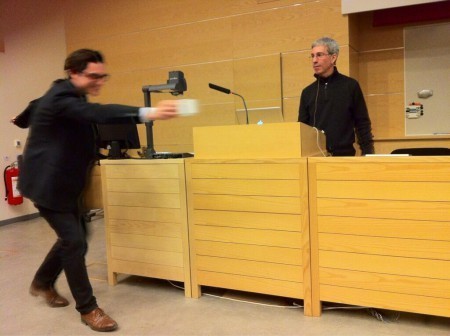Marc Abrahams's Blog, page 508
March 15, 2013
De-apostrophication in Britain
Comes the news, reported by the BBC, that :
Apostrophe ban on Devon council’s new street names
The apostrophe is being banned from street names in parts of Devon to “avoid potential confusion”. Mid Devon District Council said its new streets had not contained apostrophes for many years, but the policy was now being made official. It said apostrophes could only be found in three street names in the district….
The report is mum as to the view taken on this by Ig Nobel Prize winner John Richards of Boston, England, founder of The Apostrophe Protection Society. Mr. Richards was awarded the 2001 Ig Nobel Prize in Literature, for his efforts to protect, promote, and defend the differences between plural and possessive.

Non-Uniform Day versus World Standards Day
March 14, 2013
Progress in academic maggot painting (part 1 of 3)
Alison Bockoven is currently a Ph.D. Student at the Entomology Department of Texas A&M University. When she’s not investigating the extent, mechanisms and consequences of genetic variation in foraging traits in the red imported fire ant (Solenopsis invicta), she finds time to create artworks using maggots covered in (non-toxic) paint. The video above shows how the technique works. Alison has also created a web-based resource explaining the process and outlining its raison d’être.
COMING SOON! Academic maggot art in the UK

Mothers are Easily Worried
This study addresses the question “Are mothers easily worried?”:
“Mothers are Easily Worried,” Cynthia M. Illingworth and Ronald S. Illingworth, Archives of Disease in Childhood, vol. 59, no. 4, April 1984, pp. 380-4. The authors, at Children’s Hospital in Sheffield, UK, explain:
“Mothers are easily worried and this cannot always be avoided. But mothers are often worried unnecessarily by insensitivity, unwise choice of words, failure to determine what they are really concerned about, by criticizing them for being over anxious and ignoring their fears, or by inadequate explanation and counselling. Much anxiety is caused by unwise remarks in an assessment clinic or by a doctor’s failure to know the normal and abnormal variations in development, behaviour, or physical growth and physical features with resulting unnecessary medicines, surgery, or special investigations. It is easy to implant a feeling of guilt by putting the blame for a child’s behaviour or handicap on the parents. Screening procedures in the newborn may cause much parental anxiety.”
(Thanks to investigator Robin Abrahams for bringing this to our attention.)
BONUS: What the lead author had to say about fingertips

Elephantine Classification of Human Ethnic Groups
Do elephants discriminate between (and perhaps against) different human ethnic groups? This study addresses that question:
”Elephants Classify Human Ethnic Groups by Odor and Garment Color,” Lucy A. Bates, Katito N. Sayialel, Norah W. Njiraini, Cynthia J. Moss, Joyce H. Poole, Richard W. Byrne, Current Biology, vol. 17, no. 22, November 20, 2007, pp. 1938–1942. (Thanks to investigator Neil Martin for bringing this to our attention.) The authors, at University of St. Andrews, Scotland and the Amboseli Trust for Elephants in Nairobi, Kenya, report:
“We show that elephants distinguish at least two Kenyan ethnic groups and can identify them by olfactory and color cues independently. In the Amboseli ecosystem, Kenya, young Maasai men demonstrate virility by spearing elephants (Loxodonta africana), but Kamba agriculturalists pose little threat. Elephants showed greater fear when they detected the scent of garments previously worn by Maasai than by Kamba men, and they reacted aggressively to the color associated with Maasai. Elephants are therefore able to classify members of a single species into subgroups that pose different degrees of danger.”
Detail from the study:


March 13, 2013
How Dead Is a Doornail? [medical investigation]
A classic article:
“How Dead Is a Doornail?“ Mike Dubik and Brian Wood, Annals of Improbable Research, vol. 1, no. 6, Nov/Dec 1995.

A phony force experiment, revolving around children
Centrifugal force, which is (technically) a phony force, is at the center of this experiment about spinning children. The video presentation is of the sort known as “spinning a yarn”:
(Thanks to investigator Laura Bassett for bringing this to our attention)

March 12, 2013
Spoon bending – two angles
There are many and varied ways of looking at the practice of ‘SpoonBending’. Here, Hugh Laurie (a.k.a. Dr. House / Bertie Wooster / &etc) and Stephen Fry (a.k.a. Oscar Wilde / Jeeves / &etc) adopt a comedic viewpoint :
Whilst Professor Yoshio Machi (a.k.a. 町 好雄) of the Department of Electronic Engineering at Tokyo Denki University, Japan, decided on a scientific approach for his 2002 paper published in the Journal of International Society of Life Information Science (a.k.a. J Int Soc Life Inf Sci) ‘Physiological Study for Spoon Bending.‘
“
There have been many TV programs in which persons demonstrate spoon bending. We are not so much interested in this, but we are interested in the mechanism of why a hard spoon bends. However, we think that it has not been reported using scientific methods because spoon bending is used as an entertainment on stage or as a child’s game. We worked with a male student at a junior high school who can perform spoon bending easily. When we made physiological measurements during spoon bending, found results were similar to physiological phenomena seen in qigong and ki-aikidou. We understood that his respiration played an important role in this spoon bending.”
Further Reading : Professor Yoshio Machi has also investigated the Brain Wave & Thermography of Mr. Uri Geller, who is a renowned SpoonBender.

How to spill coffee: a science demonstration
Neuroscientist Gustav Nilsonne demonstrates how and why it’s difficult to walk while carrying a cup of coffee. This photo was taken at last night’s Ig Nobel show at the Karolinska Institute in Stockholm Sweden. The physics of this led to an Ig Nobel prize being awarded year to Rouslan Krechetnikov and Hans Mayer for their study “Walking With Coffee: Why Does It Spill?” [Physical Review E, vol. 85, 2012]. The photo was taken by Ig Nobel Prize winner Kees Moeliker, who also was part of last night’s show.

March 11, 2013
Portions are illegible
Portions of this document [click link to see the document] are illegible, says the first page of the document. It may be correct:

Marc Abrahams's Blog
- Marc Abrahams's profile
- 14 followers






